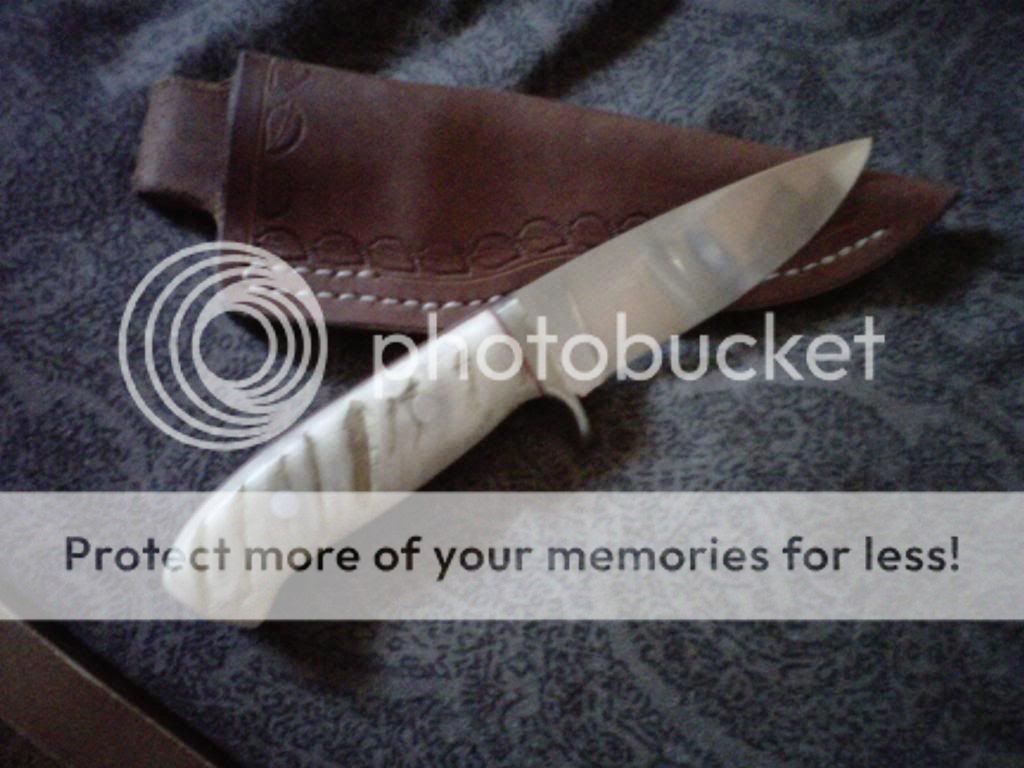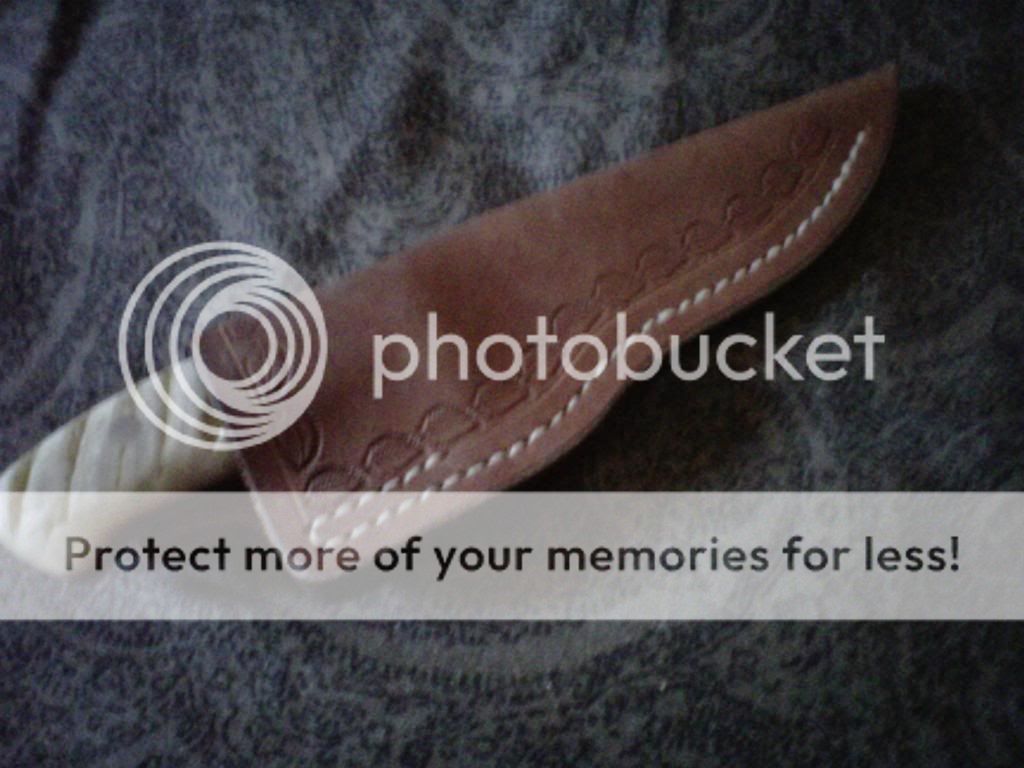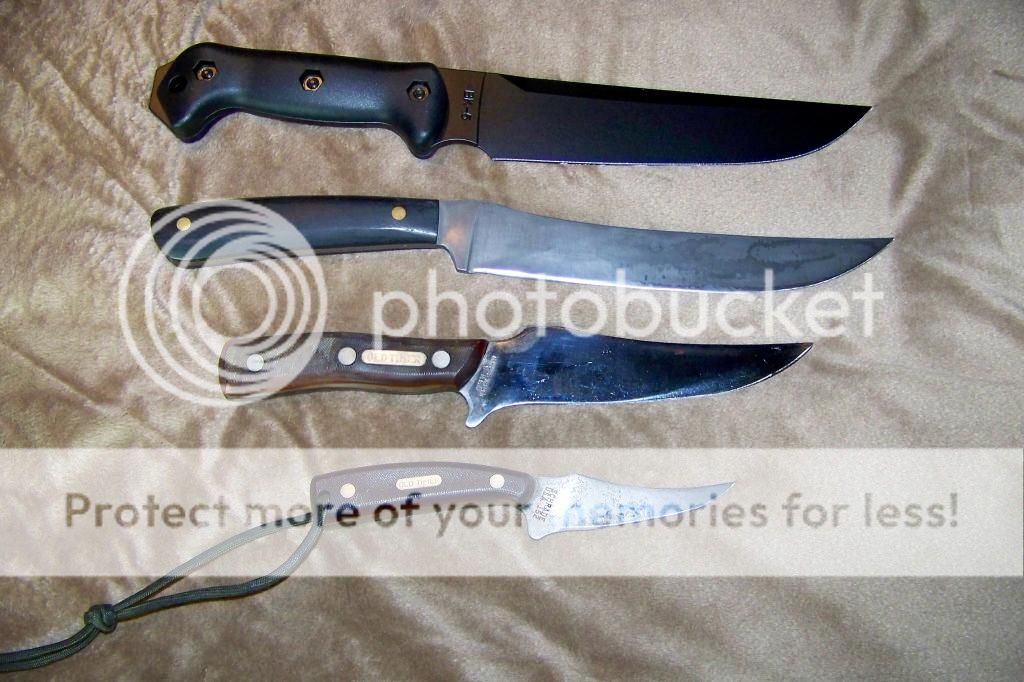I received my Fallkniven F2z last Wednesday and could'nt wait to open the package and see it in the flesh. The knife came with Zytel sheath of course (No leather option on the F2, most likely because of safety reasons due to its penetration ability), Fallkiven stickers and a small placitc stand bearing the Fallkniven name were also included with the courtesy of my supplier- It pays to be a loyal customer. I also really appreciated Fallkniven's comprehensive description and information of the knifes uses written on the unfussed white box packaging common with all mainstream Fallkniven models.
I will describe the knife for anyone who's interested in using this knife for hunting, fishing, camping, adventure or survival purposes like I intend to do. The handle seems to fit my medium sized hand perfectly. As with most Fallkniven 'F' handles it has a subtle blade safety guard design, however I also noticed the rear of the handle does a very good job of preventing you're hand from slipping off the handle and loosing the knife, while cutting through things, even if the handle is covered in blood and guts! Although I did'nt, one review mentioned sanding down the cremonum handles texture as they found it a little rough on their hands. While I have more office warrior type hands than those of the caliced bricklayer, I personally would'nt recommend doing this believing that the depth of texture is necessary when dressing game can and does get messy and I believe the texture is likely to round smoother with age.
The blade is perfect at is relatively short (As the company describes) 4.3 inches in length for a belt/ sheath knife. I've mentioned in previous knife reviews I find this the best compromise for such a knife not only when hunting, but for general purpose use about the camp and on all my outdoor adventures. The accepted compromised length range for ultimate survival knifes being between 3.8" inches and 5.1 inches). For example I noticed the F2z's blade was just long enough to cut a loaf of Vienna bread without having to turn it. At 2.5mm thick some may criticise this knife where durability is concerned in field and survival applications, and I am inquisitive in this regard, but more on that later. The geomerty of the F2's blade shape makes this knife born to slice and cut, not to mention penetrate! The first thing I noticed about actually using this knife is that contol is uncanny. Sure Fallkniven states the F2, quote, 'cuts anything quickly and precisely', although what you will come to really appreciate is the concept is so effotless! When sectioning a lamb carcass, because cutting is so quick and effortless, you find yourself nestling the spine of the burried blade against bone, which helps aid you're navigation. I managed to davour a large chicken in minutes and cut up a side of lamb with this knife, cutting through bones joints, tendons and all with ease.
This is where blade thickness comes into play; and as mentioned earlier is perhaps the only criticism some may level at the F2 as far as considering it for survival knife category. At 2.5mm thick this is a relatively strong blade and with Fallknivens' first, world leading laminate technology, the company states you can expect a further 20% increase in strength than other quality stainless and carbon blades. The blade does flex ever so slightly during moderate to heavier going, however this aids in making your work with the knife so effortless, and I believe could even absorb impacts with bone and other objects during heavier use thus protecting or at least reducing its structure from cracks and its edge from chipping/ bluntening. Consider also the slender and relatively thinness of the F2's blade gives you another plus,considered essential by many adventruers, survivalists, outdoorsmen, campers, hikers and military people and that is lightness. While Fallkniven does not publish the weight of the F2z on its website, I estimate the F2z to be less than half the weight of the F1z Military Pilots Survival Knife, which weighs in at 150 grams and the F1z is the knife considered by many to be the best contemporary, practical, weight-compromising survival knife in the world.
Tip penetration and progression is first rate and was one of the deciding factors that helped me choose and begin to consider this knife as a general purpose survival knife. The the end of the blade is honed to a very sharp point, and what I found interesting and unlike many similar blade designs even the spine of the knife is contoured to accomodates this sharp point. Fallkniven states while the F2 is primarily designed for 'filliting, cutting and cleaning fish', although it is also categorized on Fallkniven's website and stated by them it can be used as a hunting knife; that it is a knife that, 'need not be put away after outdoor use but can be utilised in the kitchen'. The slender blade allows it when dressing to stab through a large chicken to its backbone and a side of lamb to the hilt with very minimal effort from you're actions. If you're needs include defence and personal security in the wild or elsewhere, I cannot stress enough that this knife is a very, very formidable companion. In fact due to the slenderness and geometry of the blade and its penetration ability I would go as far as saying it could serve as one of the best trench knifes ever! That said be warned it is a very dangerous knife and needs to be treated with respect and safety during use and kept in its factory sheath and out of harms way when not in use. I say this not to out of exaggeration or melodrama, but aside from Fallkniven's world leading extremely stay-sharp VG10 steel laminate metalorology risking cutting injury, if you fell on this knife it would most likely kill you.
Austhetics. While the blade geometry of the F2 is by no means a new design it is strikingly unique. At first glance you either love it or hate it. However, I ask you to be intrigued by it if not to consider it, using the intelligible Swedish minimalist idom 'form follows function' as you're guiding priority. When studying the knife, you notice that the contours of the blade and the factory honed point exude competence and agressiveness.
Verdict: Can one even entertain the thought that the Fallkniven F2z is the worlds best survival knife, or is it nothing more than an excellent fishing knife or an ultimate kitchen knife at best? I will discuss this by comparing and contrasting the Fallkniven F1z, which is highly regarded as being the best survival knife in the world today, as far as practicality and purpose is concerned. If we account for the fact that the critical and universally accepted deciding factors of 'purpose' and 'practicality' are best priorities in choosing the ultimate survival knife, it could be argued the F2 becomes a very challenging alternative, to even the Fallkniven F1z. If I were to be completely honest personal human preference is also one of them- although this can sometimes often be categorized in higher proportions with factors like purpose and practicality. A very wise forum member once said somthing I have never forgotten and has became the cricual thesis behind my personal choice of both a belt knife (or sheath knife) and a folding knife (or pocket knife), "The best knife is the one you have with you". The F2z is definetely a knife you can have with you at less than half the weight of even the F1z (F1=150grams), yet with a longer blade (F2z 4.3 inches) than F1z's (3.8 inches) yet F2z is still very compact by survival knife blade standards. Fallkniven categorizes the F2z as a hunting knife, yet as their International Sales Manager Mr. Heitenforgen accentuated, all Fallkniven's are built with strength and durability in mind and with the views that while their history and influences on manufacture are steeped in Scandinavian hunting and fishing, their knifes are designed with the view that a person will use their knifes for many tasks, separate and other to what the knife was categorised to be used for. With this and all the aforementioned information in mind the F2z is a perfect fishing, camping, backpacking, food and general purpose outdoor utility knife. In terms of survival applications the F2z would perform very, very well indeed in terms of dressing small and medium game, cutting, slicing, penetrating and defence, and in light if these needs it is extremely durable while being a relatively strong knife. That said the F2 knife is not suited for prying, battoning or chopping, however the F1 is not only barely capable of these tasks, supporting reviews I have read support that the F1z barely has the blade length to accomplish such tasks and you risk damaging the blades tip in battoning, drop point blade design aside. Added to this reviews further support the F1z is not recommended for battoning as the primary purpose of a knife is cutting, so why risk the only survival tool you have for tasks like building a shelter or raft, when such tasks can be accomplished by hand and careful selection of available materials. It could further be argued that the drop point blade design of the F1z while offering more strength than F2z in prying tasks, it is 99% less effective where the task of penetration is concerned- the latter an important task when dressing game and vital one where self defence is concerned, crucial and sometimes forgotton elements with a combat (fighting knife)/ survival knife. It is for all these reasons I rate the Fallkniven F2z as the worlds best combat/ survival knife and the worlds best hunting belt (sheath knife).








